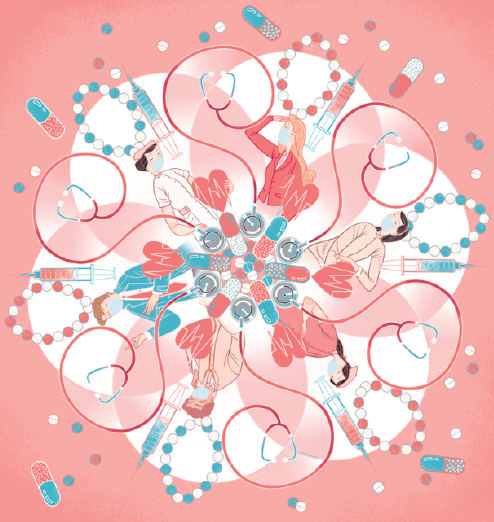Lessons to be learned


To prevent a future epidemic more must be done to improve national and global preparedness for disease emergencies
Globalization and rapid transportation systems have enabled the rapid spread of the novel coronavirus around the world, leaving the governments of the worst-affected countries with no other option but to resort to unprecedented massive population control and confinement measures.
The virus has spread fast, not just in China, but also in other Asian countries and beyond. And equally contagious has been the fear and anxiety that has resulted from an overexposure to media reports, and the explosion of fake information shared on social media.
While the epidemic is a manifestation of mega trends such as globalization and hyper connectivity, it should not be seen as fatal. It should galvanize us to act and raise our ambitions by not only being better prepared for the next one but also being able to prevent it from happening. We are entering a new epidemic era.
There will be a before and after the novel coronavirus epidemic and we have a choice here: either we let things drift back to what they were before the crisis and slide into an unpleasant future where wearing protective masks and avoiding social contacts becomes the norm, or we take it as a chance to revisit the way we address public health threats so that we increase our preparedness and prevention capabilities.
As simple as it may sound, prevention and preparedness remain the golden standard for preventing infectious disease to occur, and a lot still needs to be done to improve national and global preparedness for disease emergencies. That requires greater investment in national healthcare systems in low-income countries and reinforcing public health systems in developed countries that are threatened by a pure economic logic. Investment in prevention and response systems at local level remains the key and will require massive financial investment and the contribution of the private sector.
However, the reflection often stops at this stage without realizing the need to act at broader scientific, economic and political scales and addressing the root causes of these diseases.
Since 70 percent of emerging infectious diseases such as the novel coronavirus are of animal origin, their control relies on the "integrative effort of multiple disciplines working locally, nationally, and globally to attain optimal health for people, animals, and the environment", as the American Veterinary Medical Association suggests.
Despite years of pilot implementation, the One Health concept still needs to be scaled up and translated into long-term policies, bringing in social and behavioral scientists, conducting joint response interventions and setting up One Health platforms that facilitate interdisciplinary collaboration.
As an example, through a multi-stakeholder and value chain approach, the novel coronavirus provides a unique opportunity to upgrade traditional fresh food markets or "wet markets" by avoiding mixing domesticated and wildlife species, implementing tighter market access rules, stricter sanitation requirements, digitalized supervision and new channels of distribution that reduce the contact between humans and animals.
However, operationalizing One Health goes far beyond such measures and includes restoring the buffer against epidemic diseases.
It is now recognized that the loss of biodiversity leaves plants and animals more vulnerable to pests and diseases, making our food production systems less resilient and more vulnerable to shocks. The intensification of livestock production systems and the loss of genetic diversity of livestock have also impacted on the health of animals and therefore people. Closely related, the impact of climate change can contribute to a wider geographical distribution of infectious diseases. Diseases such as Rift Valley Fever that are transmitted by mosquitoes could expand their geographical range due to a change in climatic conditions favorable to certain species of mosquito.
Restoring the buffer against epidemics through nature-based solutions will contribute to preventing the emergence of livestock diseases that can compromise the safety of our food and threaten people's health. This means addressing other major issues such as the impact of climate change, the vulnerability of our ecosystems, and the impact of poverty and inequality on health.
Programs and interventions related to restoring ecosystem services, preserving biodiversity, protecting wetlands, improving forest coverage, reducing soil pollution would all contribute to reducing the risk of disease emergence by restoring the buffer against epidemic diseases and should be further streamlined in national government policies. This is no simple task. It puts a lot of responsibility on governments but also on specialists such as veterinarians, agronomist and ecologists. It will also require the training of specialists.
In the world of experts we live in, we need to create a generation of silo fighters, trained to embrace the full complexity of global problems, including emerging infectious diseases and their connectivity with politics, religions, culture and economics. One important lesson is that forming multidisciplinary teams is essential to deal with public health threats, but it is not sufficient. It can only work if various partners work toward a common goal, led by a clear direction in order to fully contribute and achieve a common objective.
One Health university curricula and professional trainings have been developing during the past 10 years. Curriculum should also better integrate the potential of innovation and technology, as a way to overcome existing barriers.
We indeed need to innovate and leverage the potential of technology to research vaccine technologies and treatments. New tools made available by artificial intelligence and big data are increasingly used to solve complex problems, including in the public health sector. For example, algorithms can be used to process big volumes of data and build models to solve complex problems. They can help improve early warning systems (global and national), track viruses, and assist in producing vaccines and drugs in a reduced amount of time. Their potential is immense and can be further harnessed. China has already been demonstrating their potential in its fight against the novel coronavirus, as it has been using drones and developing apps and computer systems to identify people at risk of contracting and transmitting the virus due to their travel history.
































